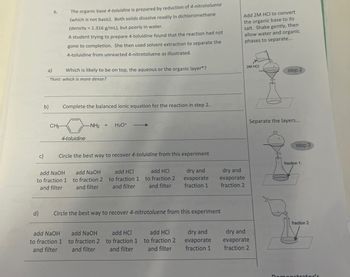
Chemistry
10th Edition
ISBN: 9781305957404
Author: Steven S. Zumdahl, Susan A. Zumdahl, Donald J. DeCoste
Publisher: Cengage Learning
expand_more
expand_more
format_list_bulleted
Question

Transcribed Image Text:c)
b)
d)
6.
a) Which is likely to be on top, the aqueous or the organic layer*?
*hint: which is more dense?
CH3-
The organic base 4-toluidine is prepared by reduction of 4-nitrotoluene
(which is not basic). Both solids dissolve readily in dichloromethane
(density = 1.316 g/mL), but poorly in water.
A student trying to prepare 4-toluidine found that the reaction had not
gone to completion. She then used solvent extraction to separate the
4-toluidine from unreacted 4-nitrotoluene as illustrated.
Complete the balanced ionic equation for the reaction in step 2.
4-toluidine
add NaOH
to fraction 1
and filter
add NaOH
to fraction 1
and filter
Circle the best way to recover 4-toluidine from this experiment
-NH₂ + H3O+
add NaOH
to fraction 2
and filter
add HCI
to fraction 1
and filter
add NaOH
to fraction 2
and filter
add HCI
to fraction 2
and filter
Circle the best way to recover 4-nitrotoluene from this experiment
add HCI
to fraction 1
and filter
dry and
evaporate
fraction 1
add HCI
to fraction 2
and filter
dry and
evaporate
fraction 1
Add 2M HCl to convert
the organic base to its
salt. Shake gently, then
allow water and organic
phases to separate...
dry and
evaporate
fraction 2
2M HCI
dry and
evaporate
fraction 2
step 2
Separate the layers...
step 3
fraction 1
fraction 2
Demonstrator's
Expert Solution
This question has been solved!
Explore an expertly crafted, step-by-step solution for a thorough understanding of key concepts.
Step by stepSolved in 2 steps with 2 images

Knowledge Booster
Learn more about
Need a deep-dive on the concept behind this application? Look no further. Learn more about this topic, chemistry and related others by exploring similar questions and additional content below.Similar questions
- 12. Arrange the following solutes in the order of increasing solubility in water: Ne, F2, Nal. (A) Ne < F₂ < Nal (B) Nal < Ne < (C) F2 < Ne (D) Ne Nal < F₂ < (E) Nal < F₂ < Nearrow_forward14.)arrow_forwardIdentify the solid that is LEAST soluble in water. Ag3PO4 Ksp = 8.89*10-17 CaCrO4 Ksp = 7.1*10-4 Cr(OH)3 Ksp = 6.3*10-31 %3D PbSO4 Ksp = 2.53*10-8 « Previous Quiz save MacBook Air 000 000 F3 F4 F5 F6 F7 $ & 4 6. * LO # 3arrow_forward
Recommended textbooks for you
 ChemistryChemistryISBN:9781305957404Author:Steven S. Zumdahl, Susan A. Zumdahl, Donald J. DeCostePublisher:Cengage Learning
ChemistryChemistryISBN:9781305957404Author:Steven S. Zumdahl, Susan A. Zumdahl, Donald J. DeCostePublisher:Cengage Learning ChemistryChemistryISBN:9781259911156Author:Raymond Chang Dr., Jason Overby ProfessorPublisher:McGraw-Hill Education
ChemistryChemistryISBN:9781259911156Author:Raymond Chang Dr., Jason Overby ProfessorPublisher:McGraw-Hill Education Principles of Instrumental AnalysisChemistryISBN:9781305577213Author:Douglas A. Skoog, F. James Holler, Stanley R. CrouchPublisher:Cengage Learning
Principles of Instrumental AnalysisChemistryISBN:9781305577213Author:Douglas A. Skoog, F. James Holler, Stanley R. CrouchPublisher:Cengage Learning Organic ChemistryChemistryISBN:9780078021558Author:Janice Gorzynski Smith Dr.Publisher:McGraw-Hill Education
Organic ChemistryChemistryISBN:9780078021558Author:Janice Gorzynski Smith Dr.Publisher:McGraw-Hill Education Chemistry: Principles and ReactionsChemistryISBN:9781305079373Author:William L. Masterton, Cecile N. HurleyPublisher:Cengage Learning
Chemistry: Principles and ReactionsChemistryISBN:9781305079373Author:William L. Masterton, Cecile N. HurleyPublisher:Cengage Learning Elementary Principles of Chemical Processes, Bind...ChemistryISBN:9781118431221Author:Richard M. Felder, Ronald W. Rousseau, Lisa G. BullardPublisher:WILEY
Elementary Principles of Chemical Processes, Bind...ChemistryISBN:9781118431221Author:Richard M. Felder, Ronald W. Rousseau, Lisa G. BullardPublisher:WILEY

Chemistry
Chemistry
ISBN:9781305957404
Author:Steven S. Zumdahl, Susan A. Zumdahl, Donald J. DeCoste
Publisher:Cengage Learning

Chemistry
Chemistry
ISBN:9781259911156
Author:Raymond Chang Dr., Jason Overby Professor
Publisher:McGraw-Hill Education

Principles of Instrumental Analysis
Chemistry
ISBN:9781305577213
Author:Douglas A. Skoog, F. James Holler, Stanley R. Crouch
Publisher:Cengage Learning

Organic Chemistry
Chemistry
ISBN:9780078021558
Author:Janice Gorzynski Smith Dr.
Publisher:McGraw-Hill Education

Chemistry: Principles and Reactions
Chemistry
ISBN:9781305079373
Author:William L. Masterton, Cecile N. Hurley
Publisher:Cengage Learning

Elementary Principles of Chemical Processes, Bind...
Chemistry
ISBN:9781118431221
Author:Richard M. Felder, Ronald W. Rousseau, Lisa G. Bullard
Publisher:WILEY